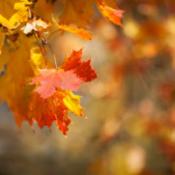 At any given time in the year, someone may be experiencing seasonal affective disorder (SAD). Spring is in full bloom in some parts of the world, but here in the United States, the amount of daylight is lessening each day as autumn nears.
At any given time in the year, someone may be experiencing seasonal affective disorder (SAD). Spring is in full bloom in some parts of the world, but here in the United States, the amount of daylight is lessening each day as autumn nears.
SAD is a form of depression that typically occurs annually in certain seasons. Between 10% and 20% of recurrent depression cases follow a seasonal pattern. Although the predominant pattern involves depression in the fall and winter months with remission in spring and summer, many people experience the reverse.
Regardless of the season, recurrent depression can take a serious toll. Below are 11 ways to help protect against SAD and keep you feeling happy and healthy in every season.
1. Know the Signs and Symptoms of SAD
Educate yourself on SAD and its symptoms to recognize the signs when they occur. Common symptoms associated with SAD may include:
- Sleeping more than usual
- Losing interest in activities and hobbies
- Lack of energy
- Difficulty focusing
- Unusual changes in appetite
- Feelings of hopelessness, sadness, or emptiness
- Persistent negative thinking
2. Exercise
A study published in The Cochrane Review reviewed 30 clinical trials and concluded that exercise does improve depression symptoms, including those associated with SAD. A regular exercise routine throughout the year can help stabilize mood and keep the body healthy. Exercising outdoors provides the added benefit of increased sunlight exposure, especially during fall and winter’s shorter daylight hours.
3. Eat Healthy
Research has revealed that diet can play a significant role in depression. A study published in the American Journal of Psychiatry revealed that women who consumed a diet high in vegetables, fruits, proteins, and whole grains had a lower risk of depression than those with a diet high in refined grains, processed foods, fried foods, and added sugars. Eating a balanced, healthy diet can help protect you against the symptoms of depression, no matter the season.
It is not unusual for a person who is depressed to crave carbohydrates, as they promote the production of serotonin (a mood-boosting neurochemical) in the brain. Help keep your brain chemistry balanced by choosing healthy carbohydrates such as lentils, brown rice, and potatoes rather than refined sugars and white breads. Eating junk food causes a sudden spike in insulin, which later leaves you with a blood sugar drop (i.e. sugar crash) and you could be left feeling lethargic and blue.Many studies have linked both depression and SAD specifically with omega-3 fatty acid deficiencies. Omega-3 fatty acids may help serotonin pass through cell membranes. Because low levels of serotonin are linked to depression, eating foods high in omega-3s (salmon, herring, and anchovies) or taking a supplement may help to stabilize mood.
Although studies have been mixed, it is thought that vitamin D may play a role in seasonal depression. In the winter season, when your exposure to sunlight decreases, so does your vitamin D production. Consider eating foods high in vitamin D (salmon, tuna, fortified milk, egg yolks, etc.) or take a daily supplement.
4. Practice Good Sleep Hygiene
Good sleep habits can help prevent seasonal depression. Keeping a routine sleep schedule can help regulate your body’s natural cycles and rhythms and keep hormones in balance. Getting at least eight hours of restful sleep each night is ideal. Going to bed when it is dark outside and waking up with the sun will also help increase your exposure to sunlight and help balance your circadian rhythm.
5. Get Outside
Take the opportunity to spend time outdoors whenever you can. Even if it is cold outside, bundle up in some warm clothes and take a brief walk outdoors. Get involved in any outdoor activities you can, even in winter. You might consider skiing or snowboarding or going outside with your child to make a snowman.
6. Increase Natural Light in Your Environment
Sometimes a simple break from your routine environment can boost your mood and give you a new perspective.Maximize the light in your home by opening blinds, drawing back curtains, trimming bushes around windows, and keeping furniture away from windows where possible. Skylights are an excellent way to increase the light in your home and keep your house warmer in the winter months. Using bright décor and light upholstery can also help to brighten your home.
Try to work next to a window in order to maximize your exposure to sunlight when indoors. If you work in an office, consider talking to your boss about moving your desk closer to a window if possible.
7. Find a Hobby
If you know you are prone to experiencing SAD, start preparing yourself early by having a good mindset going into the season. Find a hobby or two that you enjoy to keep you feeling busy and goal-oriented. Having a new challenge or project to work on can help improve your mood and prevent feelings of stagnancy.
8. Socialize
This one might seem obvious, but spending time with family and friends can help prevent and alleviate the symptoms of SAD. Unfortunately, people suffering from depression tend to isolate themselves from their loved ones. Help protect yourself from SAD by keeping a regular schedule of social activities. If you are already experiencing symptoms, you may benefit from a support group that could help you connect with others who have similar experiences.
9. Take a Vacation
If all else fails when the weather is making you blue, take a vacation to a sunnier climate if you’re able. Scheduling your vacation during the winter can help give you a break from the cold and increase your exposure to sunlight when you may need it the most.
Even if you experience SAD in the spring and summer seasons, you may still benefit from a vacation, and it doesn’t have to be one you spend much money on. Sometimes a simple break from your routine environment can boost your mood and give you a new perspective.
10. Use Light Therapy
Light therapy has proven to be an effective treatment for many with SAD. Studies have shown that 30 minutes of daily light therapy helps to improve mood and boost energy levels.
Several different devices are designed to provide necessary light, such as dawn simulation, portable light boxes, special light bulbs, and battery-powered head visors. These devices are designed to emit light that mimics the sun’s rays. It is best to be cautious when trying out new light therapies, and always talk to your physician if you are feeling unsure of personal safety and health precautions.
11. Try Talk Therapy
Talk therapy—particularly cognitive behavioral therapy (CBT)—has been shown to be effective for treating SAD. In fact, a recent study (Contie and Wein 2013) showed that individuals who received cognitive behavioral therapy had less recurrence of SAD than those treated with light therapy, which is typically thought to be one of the most effective treatments.
A cognitive behavioral therapist can help patients identify and transform negative self-defeating thoughts as well as help them implement new behaviors to help combat depression.
If you or a loved one experiences seasonal depression, consider talking with a therapist who can help you both prevent and alleviate symptoms in every season.
References:
- Contie, V. and Wein, H. (2013 January). Beat the Winter Blues: Shedding Light on Seasonal Sadness. NIH: News in Health. Retrieved from: http://newsinhealth.nih.gov/issue/Jan2013/Feature1
- Diseases and Conditions: Seasonal Affective Disorder. Mayo Clinic. Retrieved from http://www.mayoclinic.org/diseases-conditions/seasonal-affective-disorder/basics/prevention/con-20021047
- IIIiades, C. (2013 April, 29). Sad No More: Preparing for Seasonal Affective Disorder. Everyday Health. Retrieved from: http://www.everydayhealth.com/depression/preparing-for-seasonal-affective-disorder.aspx
- Jacka, F.N., Pasco, J.A., Mykletun, A., Williams, L.J., Hodge, A.M., O’Reilly, S.L., et al. (2010) Association of Western and traditional diets with depression and anxiety in women. Am J Psychiatry. 167(3):305–11. doi: 10.1176/appi.ajp.2009.09060881
- Rimer, J., Dwan, K., Lawlor, D.A., Greig, C.A., McMurdo, M., Morley, W., Mead, G.E. (2012). Exercise for depression. Cochrane Database of Systematic Reviews 2012, (7). doi: 10.1002/14651858.CD004366.pub5
- Roecklein, K. and Rohan, K. (January 2005). Seasonal Affective Disorder and Overview and Update. Psychiatry MMC. (Edgemont). 2005 Jan; 2(1): 20-26. U.S. National Library of Medicine. National Institutes of Health. Retrieved from: http://www.ncbi.nlm.nih.gov/pmc/articles/PMC3004726/
- Winter depression? Eat These Foods to Help Treat Seasonal Affective Disorder. Eating Well. Retrieved from: http://www.eatingwell.com/nutrition_health/nutrition_news_information/winter_depression_eat_these_foods_to_help_treat_seasonal_affective_disorder_sad
© Copyright 2015 GoodTherapy.org. All rights reserved. Permission to publish granted by GoodTherapy.org Staff
The preceding article was solely written by the author named above. Any views and opinions expressed are not necessarily shared by GoodTherapy.org. Questions or concerns about the preceding article can be directed to the author or posted as a comment below.

 Does Your Mood Change with the Seasons?
Does Your Mood Change with the Seasons? Dealing with Mental Health Issues During the Summer
Dealing with Mental Health Issues During the Summer Suicide in the Spring: Practice Prevention as Seasons Change
Suicide in the Spring: Practice Prevention as Seasons Change